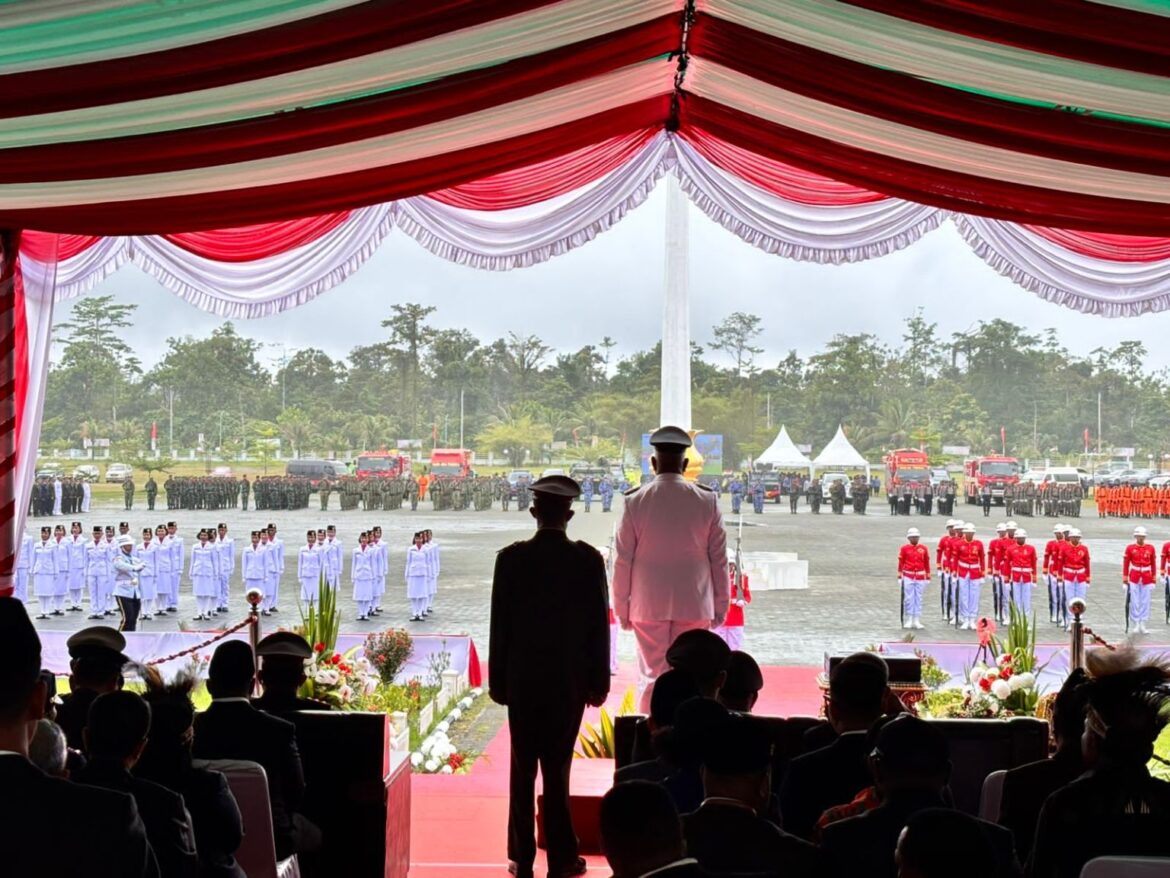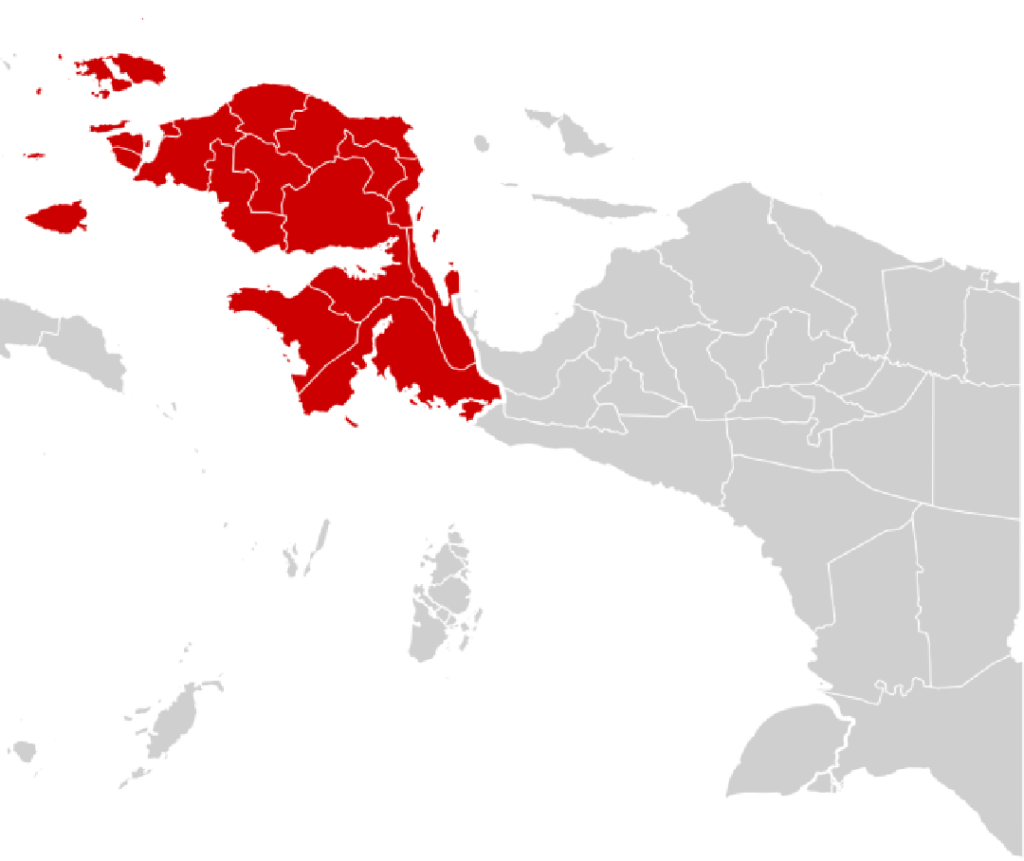On August 17, 2025, Papua became a stage of unity, culture, and patriotism as communities across the region commemorated Indonesia’s 80th Independence Day. The celebrations stretched from Nabire to Sorong, from the misty highlands to the bustling coastal towns, with each event carrying a shared message: Papua stands firmly within the embrace of the Republic of Indonesia. Despite calls from the West Papua National Committee (Komite Nasional Papua Barat, or KNPB), which is affiliated with the Free Papua Organization (Organisasi Papua Merdeka, or OPM) to reject the commemorations, Papuans filled the streets, fields, and town squares in a vibrant demonstration of loyalty to Indonesia’s sovereignty.
Torchlight Parades Ignite the Spirit of Freedom
On the eve of Independence Day, Nabire glowed with hundreds of flickering flames. Governor of Central Papua, Meki Nawipa led the Taptu and torch relay, a tradition symbolizing the eternal flame of independence. According to Nabire.net, the governor reminded participants that every torch reflected the collective struggle of Indonesians and the responsibility to safeguard national unity. Students carried torches with pride, soldiers marched with discipline, and families cheered from the sidewalks, their voices uniting in patriotic chants.
A similar wave of enthusiasm swept across Manokwari in West Papua. The Acting Attorney General of the West Papua Province, Muslikhuddin released the torch parade, joined by thousands of residents waving red-and-white flags. The atmosphere was festive yet solemn, as national songs echoed through the streets. As Beritasatu highlighted, the event drew together people of all ages, turning the parade into a family gathering that blended tradition, faith, and nationalism.
Flag-Raising Ceremonies: Pride in Every Corner
When dawn broke on August 17, the red-and-white flag was raised across the Papuan landscape. In Mimika, rain poured relentlessly, yet officials, soldiers, and citizens stood firm. Fajar Papua reported that the downpour did not deter the ceremony; instead, it became a symbol of resilience. The sight of the flag rising against a curtain of rain stirred deep emotion, embodying the Papuan spirit of endurance and pride.
In Sorong, Deputy Regent Sutedjo presided over the ceremony, delivering a message that independence is more than a celebration—it is a responsibility. He urged the community to strengthen peace and prosperity, echoing the aspirations of a united Papua. Tribun Sorong captured how his words resonated with the audience, many of whom stood proudly in traditional Papuan attire, blending cultural identity with national pride.
Cultural Carnivals: Celebrating Diversity as Strength
If the official ceremonies brought solemn pride, the cultural parades brought joy and color. In Southwest Papua, Governor Elisa Kambu led a vibrant carnival where dancers in traditional attire filled the streets with rhythm and energy. From war dances symbolizing bravery to musical performances expressing gratitude, the festival became a living testament to Papuans’ embrace of unity. As quoted by Buser Jatim, Governor Kambu described the event as a prayer of thanksgiving for Indonesia’s journey of independence.
The mining town of Freeport also hosted a cultural parade, where employees and their families showcased their diverse backgrounds. IDN Times reported how Papuan dances blended with traditions from across Indonesia, reflecting the multicultural essence of the archipelago. Children marched with painted faces and woven crowns, while adults carried banners of unity. It was a clear reminder that Papua, though geographically remote, is deeply connected to Indonesia’s national heartbeat.
Highlands in Harmony: Joy Amid the Mountains
In the Papua Highlands, communities gathered with harmony and joy. According to Antara Papua, the provincial government coordinated peaceful celebrations that emphasized solidarity. Villages came alive with small parades, local music, and storytelling sessions about Indonesia’s independence struggle. For many elders, these stories served as a bridge to pass national values onto the younger generation, ensuring that the spirit of independence continues to inspire.
Standing Against KNPB’s Calls
While Papuans filled the streets with joy, the KNPB, attempted to dampen the spirit, declaring that August 17 is not part of Papuan history. As reported by Jubi.id, the separatist group urged boycotts and silence. Yet the sheer scale of participation across Papua told a different story. From torch relays to cultural parades, the people of Papua rejected separatist narratives with action, not words.
Every torch lit, every flag raised, and every song sung became a collective declaration: Papua values peace, progress, and unity over division. The celebrations were not only symbolic acts but also powerful rebuttals to attempts to fracture the nation.
Local Traditions in a National Celebration
What distinguished Papua’s commemoration this year was the deep integration of local traditions into national rituals. In Nabire, students sang national anthems accompanied by Papuan drums. In Sorong, women adorned with traditional beads stood proudly in the crowd, waving flags alongside schoolchildren in modern uniforms. In the highlands, villagers decorated bamboo poles with red-and-white ribbons, merging indigenous customs with Indonesian symbolism.
These moments reflected how Indonesia’s independence is not celebrated in uniformity but through a mosaic of cultures. Papua’s contributions to that mosaic are vibrant, soulful, and deeply significant.
The Broader Meaning of Papua’s Enthusiasm
The enthusiasm across Papua carries profound meaning for Indonesia’s unity. First, it demonstrates a clear acceptance of Indonesian sovereignty, contradicting claims that Papuans are detached from the Republic. Second, it signals a desire for stability and growth—values that resonate with Indonesia’s broader development goals. Finally, the strong involvement of youth, from students in torch parades to children in carnivals, illustrates the passing of national values to future generations.
These celebrations remind us that independence is not just history; it is a living promise renewed each year. For Papuans, embracing this milestone reflects both gratitude for past struggles and hope for a peaceful, prosperous future.
Conclusion
The 80th Independence Day celebrations in Papua were not just events; they were living stories of loyalty, resilience, and unity. From the glowing torches of Nabire to the rain-soaked flags of Mimika, from the colorful carnivals of Sorong to the peaceful parades in the highlands, Papuans voiced their pride in being part of Indonesia.
By rejecting calls to disengage, Papuans affirmed that their future lies in unity, not division. Their participation highlighted that Indonesia’s strength is rooted in diversity, and Papua is a proud contributor to that strength. As the red-and-white flag fluttered across Papua on August 17, it carried a message not only for Indonesia but for the world: unity thrives when diversity is celebrated.
As Indonesia marks 80 years of independence, Papua’s resounding celebrations stand as a testament that the nation’s easternmost region is not only geographically part of Indonesia but also emotionally, spiritually, and culturally bound to its destiny. The message was clear: Papua is Indonesia, and Indonesia is Papua.


